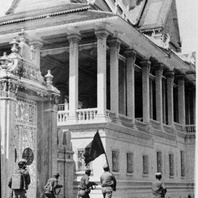
Featured Item
Troops advancing on the Royal Palace
This picture shows troops of the Kampuchea United Front for National Salvation (KUFNS, also known as FUNSK) [Front or Renakse] advancing along the Royal Palace during the takeover of Phnom Penh in January 1979. This image was featured in the publication (French and English versions) entitled The People’s Republic of Kampuchea (1979). This photograph is part of the collection held by the Agence Khmère de Presse (AKP) and Cambodia’s Ministry of Information. This collection, which documents the early years of the People’s Republic of Kampuchea as photographed by the Vietnamese and a small team of Cambodian photographers, has not yet been classified or indexed.
Read More
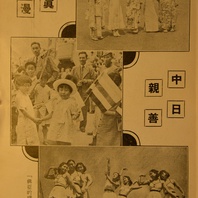
Item
Zhong-Ri qinshan, tianzhen lanman (Sino-Japanese amity, innocent and unaffected)
This series of unattributed photographs is taken from the Daminhui publication Xin Zhongguo (New China) 3.1 (January 1940). They are used here to present scenes of “Sino-Japanese friendship”. In the top two images, Chinese and Japanese children greet each other and waves the flag of Japan and of the Reformed Government of the Republic of China (RGROC). In the image at the bottom of the page, some unnamed performers do an “autumn dance” (qiu wu) entitled “Xing Ya de shuguang” (The light of a revitalized Asia).
Read More
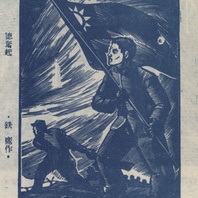
Item
Zong fenqi (Uprising)
This woodcut, by an artist called Tie Ying (lit. “iron eagle”), was reproduced in Zhonghua huabao (Chinese Pictorial) 2.2 (March 1944). The importance of the muke (woodcut) form to artistic practice in occupied China has been almost entirely overlooked in the literature. The muke form has hitherto been associated with the art of resistance in China, despite being an important part of “occupation” visual cultures as well. In this case, the image of Chinese men, dressed in their “New Citizens Uniforms” (Xin guomin zhifu) and waving the ROC flag as they run into battle against enemies unseen, looks almost identical to early wartime resistance muke.
Read More
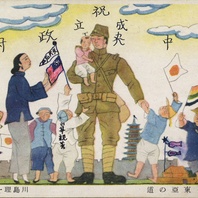
Item
Kagayaku Tōa no michi (The road to a shining East Asia)
This postcard, featuring an illustration by the prolific Japanese artist Riichiro Kawashima, shows a Japanese soldier celebrating “kagayaku Tōa no michi” (the road to a shining East Asia), with Chinese civilians. Of interest here is the fact that the Republican Chinese flag appears to have been drawn onto the postcard (and made to look as if it is being held by the child dressed in white), while other figures in the image hold the “five-coloured flag (wuseqi). The “five-coloured flag” was used by the Reformed Government of the Republic of China (RGROC) up until March 1940, but was replaced by the Republican Chinese flag with the formation of Wang Jingwei’s government. This suggests that the postcard was made prior to March 1940, but used some time thereafter. Text reading “qing zhu xin zhongyang zhengfu chengli” (Celebrating the founding of the new central government) has also been added above the figures, while the phrase “Ri-Hua qinshan” (Japanese-Chinese friendship) has been added to the boy in white.
Read More
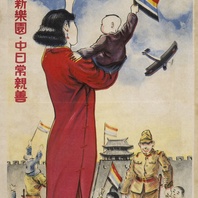
Item
Ertong xin leyuan, Zhong-Ri chang qinshan (New paradise for children; China and Japan will forever be close)
This poster, almost certainly produced with the aim of encouraging civilians in occupied Beijing to embrace Japanese rule, includes many of the standard tropes of early occupied north China propaganda: a “new woman” with a male child; city walls; Japanese soldiers fraternising with Chinese infants; the “five-coloured flag” (wuseqi); and a sky filled with Japanese airplanes.
Read More
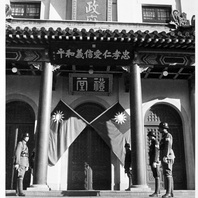
Item
Entrance to RNG Government Headquarters
Chinese and Japanese soldiers guard the entrance to the ceremonial hall (litang) of the national government compound in Nanjing in November 1940. Above the door is a plaque, written by the head of the (non-RNG) national government Lin Sen, which reads: “Loyalty, benevolence, righteousness and peace” (zhongxiao, ren’ai. xinyi, heping). Note that the “unadulterated” Nationalist Chinese flag (without the yellow pennant that the RNG had been forced to attach by the Japanese in spring 1940) is flown here.
Read More
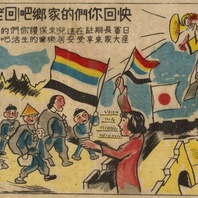
Item
Kuai hui nimen de jiaxiang ba! (Hurry back to your homes!)
This leaflet, produced with the aim of encouraging civilians in occupied north China to return to cities and towns under Japanese rule, includes many of the standard tropes of early occupied north China propaganda: a “new woman”; city walls; the “five-coloured flag” (wuseqi). The text on the leaflet reads: “Hurry back to your homes! Return to your hometowns! The Japanese army will be here for a long time. Come and protect your livelihoods and your assets. Everyone can savour living in peace and enjoying their work again”.
Read More
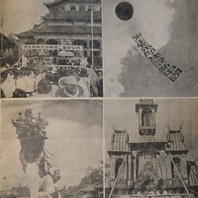
Item
Celebratory ceremony marking the second anniversary of Guangdong’s ‘rebirth’
This series of photographs is taken from Huanan huabao (South China graphic) 2.6 (1940), and shows celebrations to mark the second anniversary of what the Japanese referred to as the “rebirth” of Guangzhou (i.e., the fall of Guangzhou) in October 1938. Note the prominence given to the Sun Yat-sen Memorial Hall, as well as the use of “folk” forms of cultural expression.
Read More
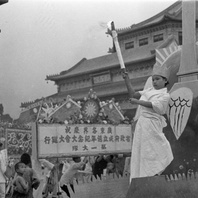
Item
Untitled (Boy dressed as angel of peace)
A boy is dressed as the “angel of peace” and rides on a float during celebrations marking the first anniversary of the founding of the Guangdong Provincial Government under Wang Jingwei in May 1941. The building in the background is the city’s Sun Yat-sen Memorial Hall (Zhongshan jiniantang).